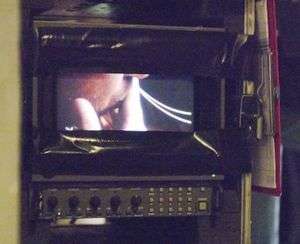Movie Making Manual/Monitoring and Measuring Exposure
< Movie Making Manual
Using BW Polaroids to determine contrast value for film productions
Polaroids are a cost effective way to pre-visualize contrast values when shooting on film. The rush to proclaim Polaroid film dead is premature as Polaroid verification of film contrast can save a film shoot thousands of dollars by preventing costly lighting mistakes. Most Successful Directors of Photography have developed other means for checking exposure, however for second unit shoots it can be an excellent way to avoid costly mistakes. For low budget shoots where every dollar has already been squeezed, avoiding costly reshoots is a no brainer that the proper Polaroid set-up can help prevent.
Not just any polaroid camera will work however. Specially modified Polaroid 110B cameras are the polaroid of choice. These cameras use Polaroid 664 and 667 film.
External Link: Polaroid Examples
Getting a video signal out of your camera
Video taps for film cameras
Monitoring the image being recorded by a film camera requires that the film camera has been fitted with a 'video tap'. This is just a little camera which sits near the view finder. The image from these cameras is often of low quality and will flicker when the camera is rolling because the rotating shutter obscures the video tap's view.
Monitors
Cabling
If using coax connections then you must make sure the coax is properly terminated. Some monitors have internal termination but these frequently fail.
Monitoring on a CRT
The desire to obsolete CRT monitoring is partially economically driven since picture tube manufacturing has been reduced by many well known manufacturers, including Sony. However CRT monitoring is still recognized as one of the most accurate methods of monitoring when a waveform/vectorscope is not available. The desire to downsize the size of the monitor and move to a flatter screen with less backend protrusion has been the desire of location production for many years now, but this size reduction has also resulted in less reliable monitoring, especially of the black levels.
Monitoring on a laptop
For DV and, soon, for HD, it is possible to monitor on a laptop. The exact features are dependent on the software but it's usually possible to do the following things using a laptop hooked up to your camera whilst recording:
- Record direct-to-disk
- Monitor the exposure more closely using a virtual scope
Examples of software which allows you to monitor on a laptop
- Serious Magic's DVrack
- Canon's Console software
Monitoring High Definition

Consider doing location monitoring High Def. Ailed the problems of backfocus associated to HD production, it's entirely possible that things can be soft, and then only spotted in the edit or later! Viewfinders are of course only wee monochrome monitors, and it's fraught with danger. Go for a 14" and have a 9" for those 'batt's only', estabilsihing shot, exteria quickies, (plenty of light, long depth of feild, da-de-da).
Monitoring exposure
It's generally A Bad Idea to judge your exposure using just the view finder. There are several tools your can use to get a more accurate measure of your exposure:
Using zebra
Many modern DV cameras come with a zebra option. This creates a white and black stripe pattern over areas of the picture that are over-exposed, allowing one to adjust the aperture, shutter speed, gain, etc. until there is no over-exposure.
Using a 'scope to monitor exposure
A scope shows you detailed information about the exposure of each shot by displaying a waveform for each channel (RGB). http://en.wikipedia.org/wiki/Vectorscope To do: add pictures of scopes in action, write more details about how scopes help monitor exposure
Using a light meter
http://en.wikipedia.org/wiki/Light_meter